共生细菌在病原体相互作用中的影响:两栖动物种群中的树枝蝙蝠疫病和假单胞菌的案例在两栖动物种群中的影响
IF 1.3
4区 数学
Q3 BIOLOGY
引用次数: 0
摘要
近几十年来,两栖动物数量的减少可能与糜烂性真菌病等传染病的发生有关,而糜烂性真菌病是由糜烂性真菌巴特拉氏菌(Batrachochytrium dendrobatidis,Bd)引起的。众所周知,共生细菌具有抑制作用,可以保护宿主。然而,两栖动物的种群动态如何受到共生细菌提供的额外效应的影响尚未得到深入分析。本文提出了一个模型来描述易感两栖动物、带共生细菌的易感两栖动物和带糜烂真菌的两栖动物之间的相互作用。当模型考虑到共生假单胞菌给宿主带来的额外繁殖利益时,如果[公式:见正文]([公式:见正文]是 Bd 的基本繁殖数量),则可能存在多个地方性平衡点。在这种情况下,[公式:见正文]处存在亚临界分岔,可能出现两个不同的无病平衡点,从而导致复杂的动力学和稳定性情况。特别是,对模型的分析表明,由于双稳态现象,即使在[公式:见正文]时,受真菌感染的两栖动物也会突然增加。在这种情况下,即使[计算公式:见正文]的值小于 1,亚临界分岔的存在也会转化为真菌的定殖,这对蝙蝠蓟马真菌来说是一种优势,因为病原体应从尽可能接近地方性平衡中获益。为了控制真菌感染,[公式:见正文]必须减小到低于 1 的值,直到地方性平衡点消失。最后,我们证明当[计算公式:见正文]增加时,两栖动物种群会达到临界种群水平,接近灭绝。本文章由计算机程序翻译,如有差异,请以英文原文为准。
EFFECTS OF SYMBIOTIC BACTERIA IN PATHOGENIC INTERACTIONS: THE CASE OF BATRACHOCHYTRIUM DENDROBATIDIS AND PSEUDOMONAS SP. IN AMPHIBIAN POPULATIONS
The decline in amphibian populations in recent decades may be linked to the occurrence of infectious diseases such as chytridiomycosis, which is caused by the chytrid fungus Batrachochytrium dendrobatidis (Bd). It is known that symbiotic bacteria protect the host due to their inhibitory nature. However, how the population dynamics of amphibians is affected by additional effects provided by symbiotic bacteria has not been analyzed in depth. In this paper, a model is proposed to describe the interaction among susceptible amphibians, susceptible amphibians with symbiotic bacteria and amphibians with chytrid fungus. When the modeling takes into account the additional reproductive benefits that the symbiont Pseudomonas sp. grants to the host, multiple endemic equilibrium points can exist if [Formula: see text] ([Formula: see text] is the basic reproduction number for Bd). In this scenario, the existence of a subcritical bifurcation at [Formula: see text], which can occur in two different disease-free equilibrium points, gives rise to complex dynamics and stability scenarios. Particularly, the analysis of the model shows that a sudden increase of fungus-infected amphibians can occur even when [Formula: see text] due to bistability phenomena. In this scenario, the existence of a subcritical bifurcation, which translates for the fungus into colonization even for values of [Formula: see text] less than one, represents an advantage for the chytrid fungus Batrachochytrium dendrobatidis since the pathogen should benefit from remaining as close as possible to an endemic equilibrium. To control the fungal infection, [Formula: see text] must be reduced to a value below one until the endemic equilibrium points disappear. Finally, we show that the amphibian population can reach a critical population level close to an extinction scenario when [Formula: see text] increases.
求助全文
通过发布文献求助,成功后即可免费获取论文全文。
去求助
来源期刊
CiteScore
2.80
自引率
12.50%
发文量
31
审稿时长
1 months
期刊介绍:
The Journal of Biological Systems is published quarterly. The goal of the Journal is to promote interdisciplinary approaches in Biology and in Medicine, and the study of biological situations with a variety of tools, including mathematical and general systems methods. The Journal solicits original research papers and survey articles in areas that include (but are not limited to):
Complex systems studies; isomorphies; nonlinear dynamics; entropy; mathematical tools and systems theories with applications in Biology and Medicine.
Interdisciplinary approaches in Biology and Medicine; transfer of methods from one discipline to another; integration of biological levels, from atomic to molecular, macromolecular, cellular, and organic levels; animal biology; plant biology.
Environmental studies; relationships between individuals, populations, communities and ecosystems; bioeconomics, management of renewable resources; hierarchy theory; integration of spatial and time scales.
Evolutionary biology; co-evolutions; genetics and evolution; branching processes and phyllotaxis.
Medical systems; physiology; cardiac modeling; computer models in Medicine; cancer research; epidemiology.
Numerical simulations and computations; numerical study and analysis of biological data.
Epistemology; history of science.
The journal will also publish book reviews.

 求助内容:
求助内容: 应助结果提醒方式:
应助结果提醒方式:


